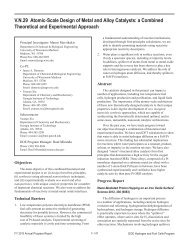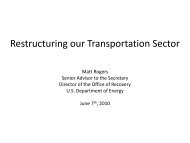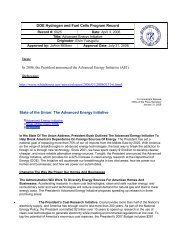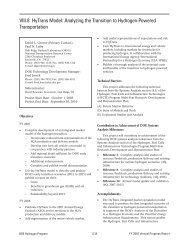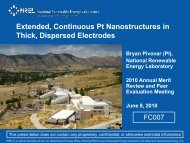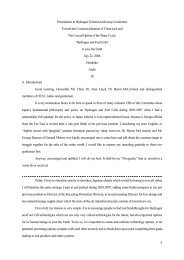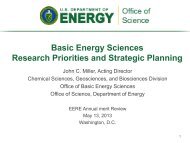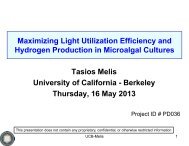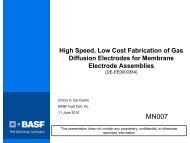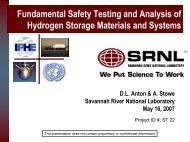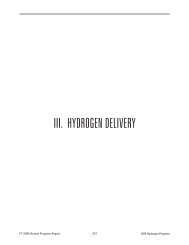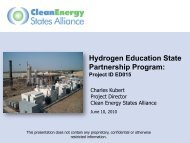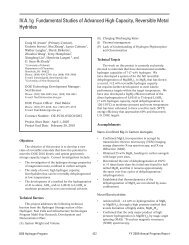Fuel Cell System for Transportation -- 2005 Cost Estimate
Fuel Cell System for Transportation -- 2005 Cost Estimate
Fuel Cell System for Transportation -- 2005 Cost Estimate
Create successful ePaper yourself
Turn your PDF publications into a flip-book with our unique Google optimized e-Paper software.
NOTICE<br />
This report was prepared as an account of work sponsored by an agency of the United States government.<br />
Neither the United States government nor any agency thereof, nor any of their employees, makes any<br />
warranty, express or implied, or assumes any legal liability or responsibility <strong>for</strong> the accuracy, completeness, or<br />
usefulness of any in<strong>for</strong>mation, apparatus, product, or process disclosed, or represents that its use would not<br />
infringe privately owned rights. Reference herein to any specific commercial product, process, or service by<br />
trade name, trademark, manufacturer, or otherwise does not necessarily constitute or imply its endorsement,<br />
recommendation, or favoring by the United States government or any agency thereof. The views and opinions<br />
of authors expressed herein do not necessarily state or reflect those of the United States government or any<br />
agency thereof.<br />
Available electronically at http://www.osti.gov/bridge<br />
Available <strong>for</strong> a processing fee to U.S. Department of Energy<br />
and its contractors, in paper, from:<br />
U.S. Department of Energy<br />
Office of Scientific and Technical In<strong>for</strong>mation<br />
P.O. Box 62<br />
Oak Ridge, TN 37831-0062<br />
phone: 865.576.8401<br />
fax: 865.576.5728<br />
email: mailto:reports@adonis.osti.gov<br />
Available <strong>for</strong> sale to the public, in paper, from:<br />
U.S. Department of Commerce<br />
National Technical In<strong>for</strong>mation Service<br />
5285 Port Royal Road<br />
Springfield, VA 22161<br />
phone: 800.553.6847<br />
fax: 703.605.6900<br />
email: orders@ntis.fedworld.gov<br />
online ordering: http://www.ntis.gov/ordering.htm<br />
This publication received minimal editorial review at NREL<br />
Printed on paper containing at least 50% wastepaper, including 20% postconsumer waste
Table of Contents<br />
Summary Report.…….......................................................................................................................iv<br />
Introduction........................................................................................................................................1<br />
<strong>Cost</strong> Analysis Assumptions..................................................................................................1<br />
TIAX Process........................................................................................................................3<br />
Independent Team Approach................................................................................................4<br />
Findings..............................................................................................................................................5<br />
Additional Observations.....................................................................................................................7<br />
Recommendations.............................................................................................................................10<br />
References.........................................................................................................................................11<br />
Appendix A.....................................................................................................................................A-1<br />
Appendix B......................................................................................................................................B-1<br />
-iii-
INDEPENDENT REVIEW TEAM SUMMARY REPORT<br />
June 21, 2006<br />
From: Independent Review Team, <strong>Fuel</strong> <strong>Cell</strong> <strong>System</strong> <strong>Cost</strong> <strong>for</strong> <strong>Transportation</strong> – <strong>2005</strong> <strong>Cost</strong> <strong>Estimate</strong><br />
To:<br />
Dale A. Gardner, NREL, DOE Hydrogen <strong>System</strong>s Integrator<br />
Subject: Independent Review Team Report<br />
Per the tasks and criteria of the Independent Review Plan of February 17, 2006, this is the Independent<br />
Review Team’s consensus technical conclusion, arrived at from data collection, review, interviews, and<br />
deliberations over the period February through May, 2006:<br />
Conclusion Statement:<br />
The Team found the methodology used by TIAX to estimate the cost of producing PEM fuel cells to<br />
be reasonable and, using <strong>2005</strong> cell stack technology and assuming production of 500,000 units per<br />
year, to have calculated a credible cost of $108/kW.<br />
Rationale <strong>for</strong> Conclusion:<br />
The Independent Review Team believes the process used by TIAX <strong>for</strong> the bottom-up determination of the<br />
cell stack costs yielded appropriate and representative results within the framework of the assumptions<br />
and recommendations from DOE and the FreedomCAR and <strong>Fuel</strong> Partnership <strong>Fuel</strong> <strong>Cell</strong> Technical Team.<br />
In general, the fuel cell companies and the national laboratories interviewed agree with the results of the<br />
TIAX cost analysis, based on the assumptions of <strong>2005</strong> cell stack technology and 500,000 units per year.<br />
<strong>Fuel</strong> cell component manufacturers agreed only with the estimated cost of their specific components,<br />
since they did not have the knowledge to comment on the total PEM fuel cell system.<br />
The TIAX cost analysis should not be used to infer that industry is prepared to manufacture 500,000 units<br />
per year based on the <strong>2005</strong> cell stack technology. Respondents stressed that the TIAX cost estimate of<br />
$108/kW is based on many design and manufacturing assumptions, including manufacture of 500,000<br />
units, $900/troy ounce platinum, <strong>2005</strong> cell stack technology, and vertical integration of the stack<br />
manufacturing process. No company is currently ready to produce either the cell stack or the balance-ofplant<br />
fuel cell components <strong>for</strong> 500,000 PEM fuel cell systems, let alone a complete fuel cell system at<br />
$108/kW. Industry anticipates major investments would be required to achieve the production volumes<br />
necessary <strong>for</strong> transportation applications.<br />
-iv-
Introduction<br />
The U.S. Department of Energy (DOE) Hydrogen, <strong>Fuel</strong> <strong>Cell</strong>s and Infrastructure Technologies<br />
Program Manager asked the National Renewable Energy Laboratory (NREL) to commission an<br />
independent review of the <strong>2005</strong> TIAX cost analysis <strong>for</strong> fuel cell production. The NREL <strong>System</strong>s<br />
Integrator is responsible <strong>for</strong> conducting independent reviews of progress toward meeting the DOE<br />
Hydrogen Program (the Program) technical targets. An important technical target of the Program is<br />
the proton exchange membrane (PEM) fuel cell cost in terms of dollars per kilowatt ($/kW). The<br />
Program’s Multi-Year Program Research, Development, and Demonstration Plan established<br />
$125/kW as the <strong>2005</strong> technical target.<br />
Over the last several years, the Program has contracted with TIAX, LLC (TIAX) to produce estimates<br />
of the high volume cost of PEM fuel cell production <strong>for</strong> transportation use. Since no manufacturer is<br />
yet producing PEM fuel cells in the quantities needed <strong>for</strong> an initial hydrogen-based transportation<br />
economy, these estimates are necessary <strong>for</strong> DOE to gauge progress toward meeting its targets. For a<br />
PEM fuel cell system configuration developed by Argonne National Laboratory, TIAX estimated the<br />
total cost to be $108/kW, based on assumptions of 500,000 units per year produced with <strong>2005</strong> cell<br />
stack technology, vertical integration of cell stack manufacturing, and balance-of-plant (BOP)<br />
components purchased from a supplier network. Furthermore, TIAX conducted a Monte Carlo<br />
analysis by varying ten key parameters over a wide range of values and estimated with 98% certainty<br />
that the mean PEM fuel cell system cost would be below DOE’s <strong>2005</strong> target of $125/kW.<br />
NREL commissioned DJW TECHNOLOGY, LLC to <strong>for</strong>m an Independent Review Team (the Team)<br />
of industry fuel cell experts and to evaluate the cost estimation process and the results reported by<br />
TIAX. The results of this independent review will permit NREL and DOE to better understand the<br />
credibility of the TIAX cost estimation process and to implement changes in future cost analyses, if<br />
necessary.<br />
<strong>Cost</strong> Analysis Assumptions<br />
DOE determined many of the top-level assumptions, in consultation with the FreedomCAR and <strong>Fuel</strong><br />
Partnership <strong>Fuel</strong> <strong>Cell</strong> Technical Team (Tech Team), which were used by TIAX in its analysis. Lower<br />
level assumptions were developed by TIAX, as required, and are described herein when they are<br />
important to understanding the overall results.<br />
<strong>Fuel</strong> <strong>Cell</strong> Configuration: DOE requested that TIAX analyze an 80-kWnet direct hydrogen PEM fuel<br />
cell system which includes the fuel cell stack and balance-of-plant (BOP) components <strong>for</strong> air, water,<br />
thermal, and fuel management, but not the hydrogen storage and power conditioning, since the latter<br />
are not included in DOE’s $125/kW target. DOE provided TIAX access to a PEM fuel cell system<br />
configuration and model developed by Argonne National Laboratory (ANL). The ANL model<br />
provides the basis <strong>for</strong> specifying the overall system, subsystem, and component per<strong>for</strong>mance<br />
parameters and the fluid and electrical interfaces.<br />
The TIAX cost analysis uses representative component designs, manufacturing processes <strong>for</strong><br />
components, the development of a bill of materials, and list of purchased components. The model,<br />
data, component designs, and results were refined on the basis of recommendations from DOE, the<br />
Tech Team, and fuel cell system and component developers.<br />
Figure 1 shows the major components of ANL’s PEM fuel cell system configuration.<br />
subsystems include:<br />
The BOP<br />
-1-
1. The air delivery system with the compressor-expander supplying pressurized air to the enthalpy<br />
wheel. The enthalpy wheel humidifies the incoming air with moisture received from the exit gas of<br />
the cathode (air) side of the PEM stack. The cathode exit gas humidifies the incoming hydrogen<br />
through a membrane humidifier be<strong>for</strong>e high-humidity gas is delivered to the enthalpy wheel. Both the<br />
compressor-expander and enthalpy wheel are powered by electric motors. The compressor-expander<br />
pressurizes the incoming air to ~2.5 bar at peak power and ~1.6 bar at 25% of peak power.<br />
2. The fuel delivery system has an ejector system <strong>for</strong> recirculation of the hydrogen when operating at<br />
the higher pressures. At low pressures an electric hydrogen recirculation pump is used. The hydrogen<br />
recirculation provides up to 99% hydrogen utilization. The membrane humidifier humidifies and<br />
preheats the incoming hydrogen. Purging of nitrogen crossing over through the PEM fuel cell<br />
membrane is required.<br />
3. The thermal management system contains a coolant pump, a radiator, and a fan. The pump and fan<br />
are powered by an electric motor.<br />
Figure 1: PEM <strong>Fuel</strong> <strong>Cell</strong> <strong>System</strong> Model developed by Argonne National Laboratory<br />
(Carlson et al. <strong>2005</strong>)<br />
Manufacturing Scale: In accordance with recommendations from DOE and the Tech Team, TIAX<br />
used current (<strong>2005</strong>) cell stack technology, assumed production of 500,000 PEM fuel cell systems (80<br />
kWnet) <strong>for</strong> automotive applications, and projected BOP technology.<br />
Catalyst Loadings and Platinum Price: Loadings and price were set by DOE’s <strong>Fuel</strong> <strong>Cell</strong> Team, with<br />
recommendations from the Tech Team, at 0.75 mg Pt/cm 2 and $900/troy ounce (troz), respectively.<br />
-2-
<strong>System</strong> Integration: For ease of analysis, DOE directed that TIAX assume vertical integration of the<br />
stack manufacture, i.e., one company would manufacture the complete cell stack from ionomer,<br />
catalyst, and bipolar plate precursor material to build a complete cell stack. The TIAX cell stack<br />
analysis is a bottom-up approach using this vertical integration assumption.<br />
TIAX Process<br />
Stack costs were estimated by evaluating known manufacturing processes and assuming they could be<br />
adapted to manufacture fuel cell components. The BOP analysis is based on component costs<br />
provided by industry and benchmark checked by TIAX.<br />
TIAX conducted both Monte Carlo (see Figure 2) and single variable sensitivity analyses on key<br />
parameters (see Table 1). The results indicate a baseline cost estimate of $108/kW and a 98%<br />
confidence that the cost would be less than DOE’s <strong>2005</strong> target of $125/kW.<br />
Figure 2: Results of Monte Carlo simulation <strong>for</strong> the variation of input parameters<br />
(Carlson et al. <strong>2005</strong>)<br />
Table 1. Parameter Values <strong>for</strong> the <strong>System</strong> <strong>Cost</strong> Sensitivity Analysis Parameter Units Minimum<br />
Baseline Maximum<br />
-3-
Independent Review Team Approach<br />
NREL commissioned DJW TECHNOLOGY, LLC (DJWT) to conduct this independent review.<br />
DJWT assembled an Independent Review Team (the Team) of four industry experts with more than 80<br />
years combined experience in fuel cell research, development, and manufacturing. Backgrounds of<br />
Team members are provided in Appendix A.<br />
The Team assessed the TIAX cost analysis (Carlson et al. <strong>2005</strong>), developed discussion points and<br />
questions, and conducted interviews with 19 companies and three national laboratories that are all<br />
active in PEM fuel cell development, plus TIAX analysis staff. These companies represented fuel cell<br />
integrators, fuel cell stack component manufacturers, and BOP manufacturers (see Appendix B).<br />
The FreedomCAR and <strong>Fuel</strong> Partnership <strong>Fuel</strong> <strong>Cell</strong> Technical Team and the DOE <strong>Fuel</strong> <strong>Cell</strong> team were<br />
also interviewed. General Motors, DaimlerChrysler, and Ford are members of the Tech Team and<br />
participated in the review as part of that team. In addition, General Motors, DaimlerChrysler, and<br />
Ford were individually contacted after the <strong>for</strong>mal independent review period (due to schedules of key<br />
personnel in those companies). Their inputs were consistent with those received from other parties<br />
and would not have materially changed the results presented in this report.<br />
The following ground rules were established <strong>for</strong> the industry and national laboratory interviews:<br />
1. The company or national laboratory would be identified.<br />
2. Responses to the questions and summary remarks would not be attributed to any specific company<br />
or national laboratory.<br />
3. No intellectual property was to be disclosed.<br />
4. Follow-up would be provided, as requested, to the companies and national laboratories.<br />
-4-
Findings<br />
The findings of the Team are the results of interviews with industry and three national laboratories,<br />
and an evaluation of the DOE-directed TIAX cost analysis, including input from the TIAX cost<br />
analysis group members.<br />
1. The fuel cell industry agrees with the methodology used in the TIAX cost analysis.<br />
The Team found the methodology used by TIAX to estimate the cost of producing PEM fuel cells to<br />
be reasonable and, using <strong>2005</strong> cell stack technology and assuming production of 500,000 units per<br />
year, to have calculated a credible cost of $108/kW. <strong>Fuel</strong> cell component manufacturers and fuel cell<br />
integrators generally agree with the PEM fuel cell system cost range of $108−$125/kW, based on the<br />
assumptions used in the TIAX report. Many of the companies interviewed did not have the<br />
knowledge to comment on the cost of the entire system, but were com<strong>for</strong>table commenting on the cost<br />
of components with which they were directly involved.<br />
Vertical integration of the stack manufacture (i.e., one company would manufacture the complete cell<br />
stack from ionomer, catalyst, and bipolar plate precursor material to build a complete cell stack) is not<br />
the model envisioned by the companies interviewed. Even so, they agreed that TIAX established a<br />
reasonable cost number—within the boundaries of the assumptions—that can be used to gauge<br />
progress in the development and eventual commercialization of fuel cells.<br />
Interviewees believed the BOP costs <strong>for</strong> the fuel cell power plant were consistent with their<br />
understanding; however, they expressed concerns that the specific system or BOP components<br />
differed from their experience and that their final power plant designs <strong>for</strong> commercial production<br />
would be different from the ANL model used by TIAX. They also expressed caveats concerning the<br />
possible BOP cost increases to accommodate application issues such as:<br />
• Cold start<br />
• Durability – reliability of BOP components with moving parts (enthalpy wheel) and<br />
humidification approach<br />
• Operability – transient response, hot day operation, hill climbing, air conditioning.<br />
The TIAX cost analysis should not be used to infer that industry is prepared to manufacture 500,000<br />
units per year based on the <strong>2005</strong> cell stack technology. Respondents stressed that the TIAX cost<br />
estimate of $108/kW is based on many design and manufacturing assumptions, including manufacture<br />
of 500,000 units, $900/troz Pt, <strong>2005</strong> cell stack technology, and vertical integration of the stack<br />
manufacturing process. No company is currently ready to produce either cell stack or BOP<br />
components <strong>for</strong> 500,000 PEM fuel cell systems, let alone a complete fuel cell system at $108/kW.<br />
Industry identified the need <strong>for</strong> manufacturing R&D, and anticipates major investments would be<br />
required to achieve the production volumes necessary <strong>for</strong> transportation applications.<br />
2. The bottom-up process used by TIAX <strong>for</strong> estimating cell stack cost is valid.<br />
The Team believes the process used by TIAX <strong>for</strong> the bottom-up determination of the cell stack yielded<br />
appropriate and representative results within the framework of the assumptions and recommendations<br />
from DOE. The BOP cost analysis was based on supplier input and the requirements were established<br />
by the ANL model. The supplier input contributed to cost projections by TIAX, which were then<br />
calibrated against TIAX’s experience with similar technologies. There is confidence in this approach<br />
within the assumptions and recommendations from DOE and ANL.<br />
-5-
3. The PEM fuel cell system model per<strong>for</strong>mance was close to state-of-the-art.<br />
The Team believes that the per<strong>for</strong>mance of the PEM fuel cell system model was close to the state-ofthe-art<br />
<strong>for</strong> the cell stack. The purpose of the ANL model is to represent a generic fuel cell system that<br />
could achieve the per<strong>for</strong>mance targets set by DOE. In particular, efficiency at rated power is targeted<br />
by DOE at 50% and efficiency at 25% of rated power is targeted at 60%. At rated power, the ANL<br />
model achieves 47% efficiency and at 25% of rated power, 55% efficiency.<br />
Some BOP components have not been fully demonstrated. Industry reported to the Team that the<br />
compressor-expander was based on data from separate devices and the combined device had not been<br />
demonstrated. The enthalpy wheel was considered bulky and its ultimate reliability was questioned.<br />
Discussions with industry identified alternative technologies that would replace the compressorexpander<br />
and possibly the enthalpy wheel.<br />
Predictably, the ANL model was accepted by some of the fuel cell manufacturers, but not by all. <strong>Fuel</strong><br />
cell integrators have their own fuel cell system designs based on their proprietary technologies. The<br />
configuration of the fuel cell system has a strong influence on the cost analysis, since it will influence<br />
the component per<strong>for</strong>mance specifications (e.g., inlet and outlet pressures, temperatures, flow-rates,<br />
and compositions) and establishes the BOP components. The ANL model may be too focused on one<br />
PEM system or one BOP component manufacturer. Industry representatives suggested alternative<br />
system designs and recommended that a study be undertaken to identify the optimum system <strong>for</strong> PEM<br />
fuel cells.<br />
4. Some cost factors may have been underestimated.<br />
Assembly of the cell stack was not addressed with the same detail as the fuel cell stack components.<br />
The TIAX approach assumes a robotic pick-and-place function that would rapidly assemble the stack.<br />
Further details on the rate of stack assembly (e.g., time to assemble a stack), the number of assembly<br />
lines, and the capital investment <strong>for</strong> these lines are needed to support the assembly costs. Careful<br />
attention to stack assembly is critical to achieving a high acceptance rate and low assembly cost.<br />
Industry recommends future DOE supported cost analyses address this issue.<br />
Industry recognizes that quality control and stack conditioning could contribute significantly to cost<br />
but were excluded from the TIAX analysis at the recommendation of DOE and the Tech Team.<br />
Industry believes quality control is critical and potentially costly to develop and implement into the<br />
manufacturing process. TIAX states that quality control and stack conditioning could add 5% − 50%<br />
to the cost. Narrowing this range will require additional analysis. Stack conditioning is addressed<br />
briefly in the TIAX report, indicating that a two-hour conditioning of the cell stack would cause a<br />
2.5% increase in cell stack cost, whereas a 24-hour conditioning would cause ~ 33% increase.<br />
5. Industry recommends incremental production cost analysis.<br />
The cost analysis <strong>for</strong> the production of 500,000 PEM fuel cell systems provides a gauge by which<br />
DOE can evaluate the progress toward achieving the cost targets <strong>for</strong> automotive PEM fuel cells and,<br />
thus, is valuable. However, fuel cell companies believe progress will be made in incremental steps<br />
with several go/no-go decisions along the way. A real target that industry does consider viable is<br />
manufacturing 10,000 PEM fuel cell systems per year. Incremental increases from 10,000 to 100,000<br />
PEM fuel cell systems are the targets <strong>for</strong> cost analysis that industry believes will be viable.<br />
-6-
Additional Observations<br />
In general, the fuel cell companies and the national laboratories interviewed agree with the results of<br />
the TIAX cost analysis, given the assumptions provided by DOE and the Tech Team. However, as a<br />
result of extensive discussions with each of the interviewees, the Independent Review Team was able<br />
to recognize (1) opportunities <strong>for</strong> future reductions in PEM fuel cell system cost as well as (2) items<br />
that could represent additional cost risk. Many of these areas are already the topics of DOE analysis<br />
and R&D.<br />
Potential Opportunities <strong>for</strong> Future <strong>Cost</strong> Reductions<br />
1. Platinum. The DOE assumption going into the analysis provided a cost range of $450−$900/troz<br />
<strong>for</strong> platinum. The price of platinum at the time of this review was in excess of $1,200/troz, and<br />
industry inputs suggest it may never return to $450/troz. However, there may be ways to limit catalyst<br />
costs:<br />
a. Platinum content can be reduced.<br />
The platinum companies stated that current platinum reserves are sufficient <strong>for</strong> the production<br />
of 500,000 PEM fuel cell systems per year. However, it would take one to two years to<br />
deliver the catalyst because production facilities are not available. Reducing the platinum<br />
content would reduce the cost of the PEM fuel cell system. Two respondents stated that<br />
platinum reductions of 50% from the baseline of 0.75 mg/cm2 had already been achieved in<br />
laboratory testing and that the durability and power density remained constant.<br />
With platinum content reductions and $900/troz, the estimated PEM fuel cell system cost<br />
could be reduced from $108 to $83/kW. Extensive cell stack testing is needed to confirm<br />
these results, and the Team recommends testing at a neutral test facility.<br />
b. End users could own the platinum.<br />
In the supply chain scenario <strong>for</strong> cell stack manufacturing, markup is applied at each stage of<br />
manufacturing. Applying markup to the high cost catalyst at each stage would increase the<br />
cost of the PEM fuel cell system. An industry suggestion is that the end producer owns the<br />
platinum and subcontracts fabrication of the catalyst, the membrane electrode assemblies<br />
(MEAs) and eventually incorporates them into stacks. End user ownership of the platinum<br />
would eliminate markup on platinum and effectively transfer the risk of platinum ownership to<br />
the fuel cell integrator or automobile manufacturer at the end of the supply chain.<br />
c. Platinum should be recycled.<br />
Many industry respondents considered the life cycle of the platinum to be an important issue,<br />
especially the possibility of recycling platinum. Recovery at levels approaching 90% is<br />
needed to combat the high cost of platinum. This topic was not addressed in the TIAX report.<br />
Recycled platinum is considered by many industry interviewees to be the only path <strong>for</strong> PEM<br />
fuel cells with platinum catalysts.<br />
-7-
d. Platinum might be profitably leased.<br />
Leasing of platinum was also brought up by industry. The manufacture of 500,000 PEM fuel<br />
cell stacks would consume approximately 2 million troz of platinum while worldwide demand<br />
<strong>for</strong> platinum was 6.7 million troz in <strong>2005</strong> (Platinum Today <strong>2005</strong>). Some fuel cell companies<br />
responded that the automobile original equipment manufacturers (OEMs) should lease the<br />
platinum (inside the cell stack) to the vehicle purchaser.<br />
2. Bipolar plates can be thinner.<br />
The TIAX cost analysis states that compression-molded, graphite-resin composite plates may have<br />
thickness and conductivity limitations (Carlson et al. <strong>2005</strong>). TIAX changed its analysis from the 2004<br />
graphite resin composite <strong>for</strong>mulation to an analysis of molded/stamped-expanded graphite foil to<br />
achieve thinner bipolar plates. A manufacturer of this type of bipolar plates disagreed with the<br />
thickness and conductivity statements of the analysis. Graphite foil also has high electrical<br />
conductivity, low contact resistance, and low specific density, and it can be manufactured in a roll-toroll<br />
continuous process with embossed compression molding.<br />
Manufacturers of both types of plates reported that thinner plates can be made. The limit on bipolar<br />
plate thickness is based on two factors: (1) permeability of reactants through the web of the bipolar<br />
plate and (2) the flow field depths required to ensure the reactants are adequately distributed.<br />
3. High power densities may be achievable.<br />
The Team was told by MEA manufacturers that power densities are achievable at greater than the 600<br />
mW/cm 2 baseline used in the analysis. Power densities of 700−1,000 mW/cm 2 have been obtained in<br />
laboratory tests. The full details were not revealed; however, the industry claims suggest cell stack<br />
cost reductions similar to those achieved in moving from 350 mW/cm 2 in 2004 to 600 mW/cm 2 in the<br />
<strong>2005</strong> baseline cost analysis. Further demonstration in cell stacks is needed be<strong>for</strong>e reduced costs can<br />
be claimed based on these data.<br />
4. Membrane electrode assembly technology is advancing.<br />
MEA manufacturers reported progress in roll processing of three-layer systems and advances toward<br />
five-layer systems. At least one manufacturer reported their three-layer, roll-to-roll process is already<br />
high volume. Some manufacturers indicated manufacturing development programs to adapt roll<br />
processing <strong>for</strong> fuel cell production would be costly, but they were moving <strong>for</strong>ward. These continued<br />
ef<strong>for</strong>ts should be encouraged and may drive down costs. Industry anticipates a nonrecurring<br />
engineering investment in the transition from three-layer (catalyst coated membrane) structures to<br />
five-layer, and possibly seven-layer structures. The application of seals in the roll processing was<br />
considered a nontrivial manufacturing problem that would require process development.<br />
Additional <strong>Cost</strong> Risk Areas<br />
1. The lower range of the ionomer cost is questionable.<br />
A Stan<strong>for</strong>d Research Institute (SRI) report (SRI 1983) reviewed ionomer costs and proposed the<br />
product value <strong>for</strong> ionomer was $60 − $89/lb <strong>for</strong> a 100,000−400,000 lb/yr (180 metric tons/year)<br />
facility. These values (in 1983 dollars) are associated with the capital investment and production cost<br />
<strong>for</strong> the ionomer and they compare well with the cost given in Table 19 (Carlson et al., <strong>2005</strong>).<br />
-8-
However, given that energy costs have increased significantly since 1983, the SRI values are probably<br />
low.<br />
The TIAX sensitivity analysis assumed a Nafion cost range from $20 − $100/lb with a most likely<br />
value of $80/lb (see Table 20 of Carlson et al. <strong>2005</strong>) that is inconsistent with the SRI study. The low<br />
cost in Table 20 is attributed to the work of Gebert et al 2004. The membrane companies indicated the<br />
low-end cost may approach $90/lb, in closer alignment with the SRI report.<br />
2. The woven gas diffusion layer is nonstandard.<br />
The gas diffusion layer (GDL) identified in the TIAX report is a woven material (Carlson et al. <strong>2005</strong>).<br />
Although the cost difference is not very significant, non-woven GDLs are used by all but one of the<br />
MEA and cell manufacturers interviewed. The choice of woven GDLs is a cost risk that does not<br />
reflect industry or national laboratory views.<br />
3. Vertical integration of cell stack manufacturing is not supported by industry.<br />
Industry consensus was that no one company had all the technology or could af<strong>for</strong>d to have all the<br />
technology to achieve vertical integration. The Independent Team concurs. The TIAX analysis did<br />
evaluate the value chain cost and included 30% markup <strong>for</strong> the catalyst. Eliminating the catalyst<br />
markup and using the end user approach identified here will reduce the supply chain cost.<br />
4. Nonrecurring engineering costs are not included in the analysis.<br />
The analysis does not include nonrecurring costs <strong>for</strong> manufacturing. Nonrecurring manufacturing<br />
engineering costs need to be recovered by companies through sales revenue. Industry participants<br />
indicated that the high cost of transitioning from limited production (
Recommendations<br />
As a result of this comprehensive review, the Team prepared the following recommendations <strong>for</strong><br />
future cost analyses of PEM fuel cell systems.<br />
1. Reduce platinum costs through recycling and alternative purchase options.<br />
Recycled platinum should be evaluated in future cost analyses. A general recommendation is <strong>for</strong> the<br />
DOE to increase its development programs on recycled platinum. A review of alternative methods<br />
of purchasing platinum is also recommended and should include purchase by the end user to<br />
minimize markup of the platinum during processing. An evaluation of the benefits of leasing<br />
platinum by the OEM or automobile manufacturers is also recommended.<br />
2. Quantify the cost of ionomer used in PEM membranes.<br />
The minimum cost of $20/lb <strong>for</strong> ionomer assumed by TIAX in its sensitivity analysis is not<br />
consistent with the available in<strong>for</strong>mation. Industry input was closer to $90/lb. A new evaluation of<br />
the cost of ionomer is recommended.<br />
3. Develop a value chain analysis of the cell stack.<br />
Value chain analysis of the cell stack should be used in all future cost analyses. The manufacturing<br />
concept of vertical integration <strong>for</strong> the cell stack should be reconsidered.<br />
4. Review the use of non-woven gas diffusion layers.<br />
Since non-woven GDLs are used by most MEA and cell manufacturers, they should be considered<br />
in all future cost analyses.<br />
5. Baseline design of the PEM fuel cell system should have broader input from industry.<br />
The PEM fuel cell system design should be reconsidered. Industry suggested alternative system<br />
designs and a study to identify the optimum system <strong>for</strong> PEM fuel cells. Any future models should<br />
be developed with broader industry and national laboratory input.<br />
6. Include nonrecurring engineering costs in future cost analyses.<br />
Nonrecurring manufacturing engineering costs need to be recovered by companies through sales<br />
revenue, and thus should be included in future cost analyses.<br />
7. Evaluate incremental production costs.<br />
Future cost analyses should address incremental production increases beginning with 10,000 units<br />
per year, in addition to the baseline of 500,000 units per year.<br />
8. Clarify intended usage of the cost analysis report.<br />
To avoid misinterpretation, future cost analyses should provide a statement in the front of the report<br />
that clearly identifies how the report should be used and not used. What can and, more importantly,<br />
what cannot be inferred from the results of the analysis should be clearly defined.<br />
9. Include more detail in future analyses.<br />
Future analyses would provide a greater understanding of the PEM costs if there were more detail<br />
provided in the bottom-up analysis.<br />
-10-
References<br />
Carlson, E.;Kopf, P.; Sinha, J.; Sriramulu, S.; and Yang, Y. <strong>2005</strong>. <strong>Cost</strong> Analysis of PEM <strong>Fuel</strong> <strong>Cell</strong><br />
<strong>System</strong>s <strong>for</strong> <strong>Transportation</strong>, Subcontract Report NREL/SR-560-39104. Golden, CO: National<br />
Renewable Energy Laboratory.<br />
Gebert, M.; Hohlein, B. et al. Nov. 2004. “Benchmark <strong>Cost</strong> Analysis of Main PEFC-Ionomer<br />
Membrane Solutions,” Trans. of the ASME, Journal of <strong>Fuel</strong> <strong>Cell</strong> Science and Technology, Vol. 1, pp.<br />
56−60.<br />
Platinum Today (<strong>2005</strong>). www.platinum.matthey.com/market_data/1147696728.html. SRI 1983. PEP<br />
(PROCESS Economic Program) #166 Fluoropolymers.<br />
-11-
Appendix A<br />
Independent Review Team<br />
The National Renewable Energy Laboratory contracted with DJW TECHNOLOGY, LLC (DJWT) to<br />
conduct the independent review. An Independent Review Team of four industry experts with a<br />
combined experience of over 80 years in fuel cell research, development and manufacturing was<br />
assembled by DJWT.<br />
DJW TECHNOLOGY, LLC: DJWT is a sole proprietorship <strong>for</strong>med by Douglas Wheeler to provide<br />
consulting services to industry, the national laboratories, and government agencies. Mr. Wheeler was<br />
manager technology and government contracts at UTC <strong>Fuel</strong> <strong>Cell</strong>s (now UTC Power) <strong>for</strong> 18 years. At<br />
UTC <strong>Fuel</strong> <strong>Cell</strong>s, he managed the Advanced Technology team during UTC <strong>Fuel</strong> <strong>Cell</strong>s’ transition from<br />
Phosphoric Acid fuel cells to PEM fuel cells. During this time period UTC <strong>Fuel</strong> <strong>Cell</strong>s’ critical<br />
atmospheric pressure technology <strong>for</strong> PEM fuel cells was developed. The Advanced Technology team<br />
developed and demonstrated the technology concepts <strong>for</strong> UTC <strong>Fuel</strong> <strong>Cell</strong>s’ automotive PEM fuel cell<br />
systems.<br />
PEM ENGINEERS: PEM ENGINEERS was <strong>for</strong>med by David Watkins and Clarence Chow, two<br />
<strong>for</strong>mer long-term directors of Ballard’s Advanced <strong>System</strong>s and <strong>Transportation</strong> Programs.<br />
David Watkins: During his 19 years at Ballard Power <strong>System</strong>s, Mr. Watkins pioneered the<br />
PEM fuel cell technologies behind Ballard's emergence as a global industry leader, including<br />
an order of magnitude increase in power density, practical operation on air rather than on pure<br />
oxygen, operation on widely available hydrocarbon fuels rather than pure hydrogen, and the<br />
first methanol-to-electricity and natural gas-to-electricity integrated fuel power plants using<br />
PEM technology. He started <strong>System</strong>s Engineering at Ballard in 1991, retired in 2002 as<br />
Director, Advanced <strong>System</strong>s responsible <strong>for</strong> portable, stationary and transportation power<br />
plants.<br />
Clarence Chow: Mr. Chow has extensive experience in fuel cell product development,<br />
particularly <strong>for</strong> automotive applications. During his 12 years at Ballard Power <strong>System</strong>s, he<br />
held the positions as Stack Engineering Manager, Director of <strong>Transportation</strong> Programs and<br />
Director of Advanced Development. He managed a number of key projects that helped to put<br />
Ballard at the <strong>for</strong>efront of fuel cell product development <strong>for</strong> automobiles. He led the stack<br />
development that advanced the power densities to the needs of the automotive fuel cell<br />
systems and improved per<strong>for</strong>mance compatibility, reduced costs, and trans<strong>for</strong>med the design<br />
<strong>for</strong> high volume production processes.<br />
Paul J. Farris Consultant: Paul Farris has over 30 years experience in the fuel cell industry at UT <strong>Fuel</strong><br />
<strong>Cell</strong>s where he was Manager of Business Development. He was a key member of the PC 25<br />
commercialization team and conducted cost and manufacturing analyses <strong>for</strong> the phosphoric acid fuel<br />
cell. He led the ef<strong>for</strong>t <strong>for</strong> UTC <strong>Fuel</strong> <strong>Cell</strong>s on the commercialization of an on-sit hydrogen generations<br />
unit. He was instrumental in the UTC <strong>Fuel</strong> <strong>Cell</strong>s’ transition to PEM fuel cell <strong>for</strong> transportation<br />
applications and was an instructor at the <strong>Fuel</strong> <strong>Cell</strong> Short Course, “The Integrated <strong>System</strong> Approach<br />
to <strong>Fuel</strong> <strong>Cell</strong> Power Plant <strong>System</strong> Design” at the <strong>2005</strong> <strong>Fuel</strong> <strong>Cell</strong> Seminar.<br />
A-1
Appendix B<br />
Interviews <strong>for</strong> Independent Review of TIAX <strong>Cost</strong> Analysis<br />
Companies & National Laboratories Interviewed<br />
Companies<br />
• TIAX, LLC<br />
• UTC Power, LLC<br />
• SGL Carbon Group<br />
• Porvair Advanced Materials<br />
• 3M Company<br />
• W. L. Gore & Associates<br />
• Ballard Power <strong>System</strong>s<br />
• Honeywell International Inc.<br />
• Plug Power Inc.<br />
• Arkema Group<br />
• E-TEK Division of PEMAS <strong>Fuel</strong> <strong>Cell</strong> Technologies<br />
• Directed Technologies, Inc (written response)<br />
• DuPont E I DE NEMOURS & CO, DuPont <strong>Fuel</strong> <strong>Cell</strong>s<br />
• GrafTech Advanced Energy Technology Inc.<br />
• Parker Hannifin Corporation<br />
• Dana Corporation<br />
• Johnson Matthey<br />
• Delphi Corporation (written response)<br />
• Hydrogenics Corporation<br />
• General Motors<br />
• Daimler Chrysler<br />
• Ford<br />
National Laboratories<br />
• Argonne National Laboratory<br />
• National Renewable Energy Laboratory<br />
• Los Alamos National Laboratory<br />
B-1
REPORT DOCUMENTATION PAGE<br />
Form Approved<br />
OMB No. 0704-0188<br />
The public reporting burden <strong>for</strong> this collection of in<strong>for</strong>mation is estimated to average 1 hour per response, including the time <strong>for</strong> reviewing instructions, searching existing data sources,<br />
gathering and maintaining the data needed, and completing and reviewing the collection of in<strong>for</strong>mation. Send comments regarding this burden estimate or any other aspect of this<br />
collection of in<strong>for</strong>mation, including suggestions <strong>for</strong> reducing the burden, to Department of Defense, Executive Services and Communications Directorate (0704-0188). Respondents<br />
should be aware that notwithstanding any other provision of law, no person shall be subject to any penalty <strong>for</strong> failing to comply with a collection of in<strong>for</strong>mation if it does not display a<br />
currently valid OMB control number.<br />
PLEASE DO NOT RETURN YOUR FORM TO THE ABOVE ORGANIZATION.<br />
1. REPORT DATE (DD-MM-YYYY)<br />
October 2006<br />
2. REPORT TYPE<br />
Independent Review Report<br />
4. TITLE AND SUBTITLE<br />
<strong>Fuel</strong> <strong>Cell</strong> <strong>System</strong> <strong>for</strong> <strong>Transportation</strong> – <strong>2005</strong> <strong>Cost</strong> <strong>Estimate</strong><br />
3. DATES COVERED (From - To)<br />
5a. CONTRACT NUMBER<br />
DE-AC36-99-GO10337<br />
5b. GRANT NUMBER<br />
5c. PROGRAM ELEMENT NUMBER<br />
6. AUTHOR(S)<br />
Douglas Wheeler<br />
5d. PROJECT NUMBER<br />
NREL/BK-150-40160<br />
5e. TASK NUMBER<br />
HS061002<br />
5f. WORK UNIT NUMBER<br />
7. PERFORMING ORGANIZATION NAME(S) AND ADDRESS(ES)<br />
Douglas Wheeler<br />
Independent Review Panel<br />
8. PERFORMING ORGANIZATION<br />
REPORT NUMBER<br />
LDC-6-66262-01<br />
9. SPONSORING/MONITORING AGENCY NAME(S) AND ADDRESS(ES)<br />
National Renewable Energy Laboratory<br />
1617 Cole Blvd.<br />
Golden, CO 80401-3393<br />
12. DISTRIBUTION AVAILABILITY STATEMENT<br />
National Technical In<strong>for</strong>mation Service<br />
U.S. Department of Commerce<br />
5285 Port Royal Road<br />
Springfield, VA 22161<br />
13. SUPPLEMENTARY NOTES<br />
NREL Technical Monitor: Michael Duffy<br />
10. SPONSOR/MONITOR'S ACRONYM(S)<br />
NREL<br />
11. SPONSORING/MONITORING<br />
AGENCY REPORT NUMBER<br />
NREL/BK-150-40160<br />
14. ABSTRACT (Maximum 200 Words)<br />
Independent review report of the methodology used by TIAX to estimate the cost of producing PEM fuel cells using<br />
<strong>2005</strong> cell stack technology.<br />
15. SUBJECT TERMS<br />
independent review; TIAX; cost analysis; fuel cells; cell stack<br />
16. SECURITY CLASSIFICATION OF: 17. LIMITATION<br />
OF ABSTRACT<br />
a. REPORT b. ABSTRACT c. THIS PAGE<br />
Unclassified Unclassified Unclassified UL<br />
18. NUMBER<br />
OF PAGES<br />
19a. NAME OF RESPONSIBLE PERSON<br />
19b. TELEPHONE NUMBER (Include area code)<br />
Standard Form 298 (Rev. 8/98)<br />
Prescribed by ANSI Std. Z39.18<br />
F1146-E(12/2004)



